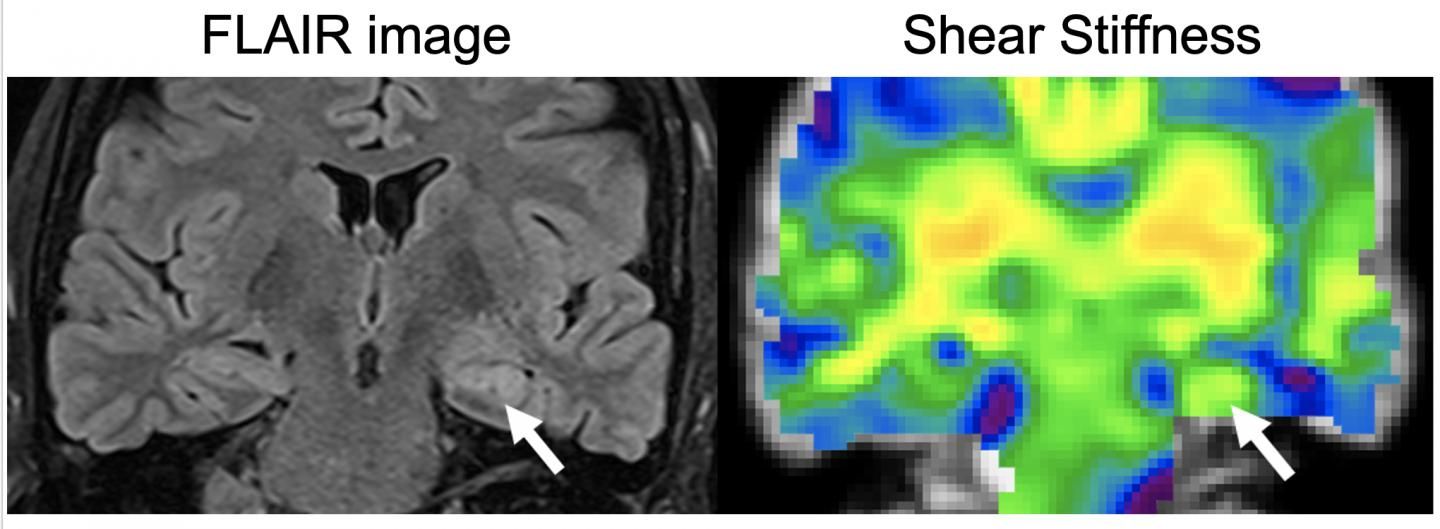Magnetic Resonance Elastography Offers Early Detection of Epilepsy-Related Brain Changes
By capturing changes to the hippocampus, MRE can pinpoint brain damage early before epilepsy becomes medication resistant.
Magnetic resonance elastography (MRE) can be used to detect changes in the brain from epilepsy before the disease has created any extensive harm.
By using MRE to compare the stiffness of the hippocampus – the part of the brain that is involved with memory – investigators can detect and characterize the disease earlier. Being able to see these alterations faster is an improvement over current MRI detection methods that can only capture epilepsy-induced changes after significant brain damage has occurred.
This work, completed by investigators at the Carle Neuroscience Institute and the Beckman Institute for Advanced Science and Technology at the University of Illinois Urbana-Champaign, was published on Sept. 3 in the journal NeuroImage: Clinical.
A FLAIR image, left, is conventionally used to show what part of the brain is impacted by the disease, is shown with the corresponding MRE stiffness map from the patient showing stiffness changes due to disease. The affected side is indicated by the arrow. Courtesy: Beckman Institute

According to the research team, this new method can be particularly helpful with mesial temporal lobe epilepsy (MTLE), the most common type of the disease that is resistant to medication.
“The structural changes in the brain, in response to seizures, causes the death of neurons and the formation of scar tissue,” said Graham Huesmann, a neurologist at Carle and a research assistant professor of molecular and integrative physiology. “By the time we see any changes on the MRI, the disease is pretty advanced. We wanted to detect these changes earlier using MRE.”
MRE, which is already used clinical to stage various liver disease and perform non-invasive liver biopsies, uses an MRI scanner to examine the stiffness of brain tissues. Specifically, there are low levels of damage to the hippocampus that appear in the early stages of epilepsy that can be identified with MRE.
But, to judge just how well MRE can effectively analyze brain tissue and identify changes in hippocampus stiffness and volume, the team used a 3T MRI to gather MRE images from 15 patients who have moderate-to-severe MTLE. Based on their analysis of these images, they discovered the ipsilateral hippocampus is significantly stiffer than the contralateral hippocampus in patients with MTLE (d=0.96; p=0.007) than in healthy patients (d=0.12; p=0.666).
“The hippocampus stiffness ratio is a potentially useful biomarker for detecting and characterizing MTLE,” the team determined, “and may provide information consistent with and complementary to other imaging measures.”
In addition, the team also discovered ipsilateral hippocampal volume is lower in patients with MTLE (d=0.91; p=0.009) than in healthy participants (d=-1.10; p=0.011).
Overall, the team said, MRE could allow for better staging of progressive epilepsies, such as MTLE, and move patient care toward earlier detection. And, being able to catch these conditions as early as possible is critical because they can produce very mild symptoms in the beginning stages that can be difficult to catch, potentially leading to medication-resistant disease.
“MRE allows us to detect these changes earlier affording us the opportunity to change the course of treatment,” Huesmann said.
These findings and the use of MRE can also change surgical decisions, said Tracey Wszalek, Ph.D., director of the Biomedical Imaging Center.
“MRE can also inform doctors about when to intervene in surgery,” she said. “If the surgery is done too early, it may affect the part of the brain that is still in use. However, if it is done too late, the patients lose their ability to make new memories.”
The team plans to continue their work, examining other types of epilepsy, Huesmann said, because it is an alternative to the imaging techniques that capture static images of the brain.
“Using MRE to see how the brain jiggles is an exciting way to approach this problem,” he said. “It is also an inexpensive technique and can, therefore, be used by anyone.”
Study: Monitoring of Prostate MRI Exams Could Lead to 75 Percent Reduction of Gadolinium Contrast
March 17th 2025While DCE MRI was deemed helpful in over 67 percent of cases in which it was used, researchers found that monitored prostate MRI exams, which facilitated a 75 percent reduction of DCE MRI sequences, had comparable sensitivity for prostate cancer as non-monitored exams.
Study: Monitoring of Prostate MRI Exams Could Lead to 75 Percent Reduction of Gadolinium Contrast
March 17th 2025While DCE MRI was deemed helpful in over 67 percent of cases in which it was used, researchers found that monitored prostate MRI exams, which facilitated a 75 percent reduction of DCE MRI sequences, had comparable sensitivity for prostate cancer as non-monitored exams.
2 Commerce Drive
Cranbury, NJ 08512
All rights reserved.